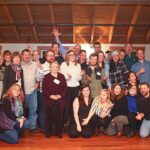BY JON SHADEL
One hundred years ago, the Willamette River might easily have been mistaken for a sewer. Unchecked industrial activity and decades of pollution made it unrecognizable compared to the clean river that now flows north for 187 miles from Eugene through the center of Portland.
BY JON SHADEL
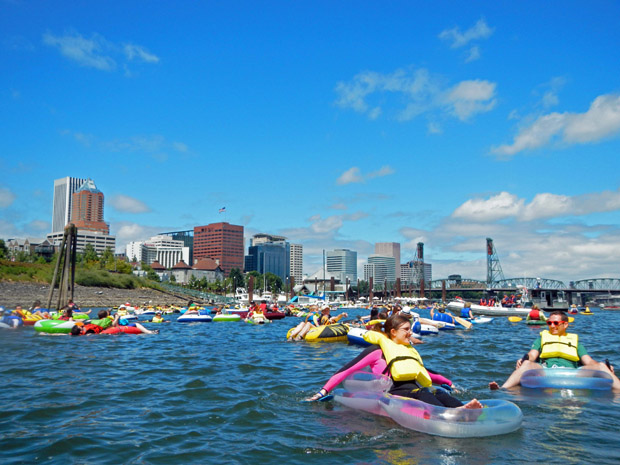
Hundreds of sun-soaked Portlanders take to the Willamette River with floaters and swim vests as a part of the annual Big Float, an event hosted by the Human Access Project to promote recreation in the river.
One hundred years ago, the Willamette River might easily have been mistaken for a sewer. Unchecked industrial activity and decades of pollution made it unrecognizable compared to the clean river that now flows north for 187 miles from Eugene through the center of Portland.
Thankfully, times have changed. Decades of conservation work and waste infrastructure improvements have transformed the health of the Willamette. And though work continues, the Oregon Department of Environmental Quality states the river is perfectly safe for human recreation.
One of the big challenges today, experts say, is improving the health of the river’s reputation.
“Portland has a very complicated relationship with the Willamette, and it has a lot to do with the river’s oral history,” explains Willie Levenson, the director of the Human Access Project, a nonprofit organization aiming to change Portlanders’ perception of the river.
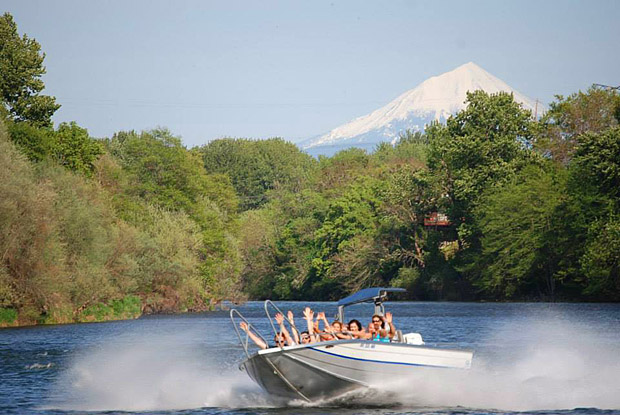
Rogue Jet Boat Adventures provide thrilling jet boat tours of the upper Rogue River. They are the twentieth business to contribute to the Oregon Travel Philanthropy Fund.
Support for Human Access comes from the Oregon Travel Philanthropy Fund (OTPF), the first statewide program to promote sustainable tourism development. The OTPF has been able to directly sponsor these efforts by partnering with businesses in Oregon’s thriving tourism sector.
“The idea for the fund is to create a mechanism where tourism businesses can help visitors give back to sustainability projects all across the state,” says Harry Dalgaard, a destination development specialist at Travel Oregon who spearheads the OTPF.
Funded by tourism businesses, the OTPF allows visitors to contribute to programs that support local culture and the natural environment across the state.
OTPF collects donations from participating businesses that are then equally distributed among different projects across Oregon. A total of seven projects are selected every two years from each of the state’s seven designated tourism regions.

A group of schoolchildren enjoys the view of Table Rock, prominent volcanic plateaus located just north of the Rogue River in Jackson County.
These projects typically focus on environmental stewardship, food and agriculture, cultural preservation, community livability and carbon-footprint reduction. Current project beneficiaries include the Nature Conservancy’s work with native oyster restoration, the Table Rock Interpretive Plan in Southern Oregon and the Fossil Education Foundation’s work in Oregon’s High Desert.
In the last few years, the OTPF has raised nearly $100,000 from 20 participating businesses that see the fund as an opportunity to demonstrate that their commitment to community and environmental sustainability runs deep.
Hospitality entrepreneurs like Emily Grimes, co-owner of Rogue Jet Boat Adventures, appreciate the OTPF’s ease of implementation and flexibility in determining how funds are collected.
“When you’re a small-business owner, you’re responsible for everything from website design to scheduling tours,” Grimes says. “The fund made it really easy to give back; it is a turnkey sustainability program.” Rogue Jet Boat Adventures provides exhilarating jet-boat rides on the upper Rogue River to thousands of guests, and on their discovery tours, they introduce visitors to the beauty of the Table Rock area. Due to Grimes’ intimate knowledge of the region, she was attracted to the OTPF because of its support of projects in her community.
“What really drew me to the fund was their support of the Table Rock area through a project that’s working to preserve the part of the state I call home,” says Grimes. By giving a percentage of profit from their ticket sales to the OTPF, Rogue Jet Boat Adventures allows visitors to help support the destination they’re experiencing. Grimes believes the fund helps visitors have a deeper connection with the destination and a more rewarding experience overall.

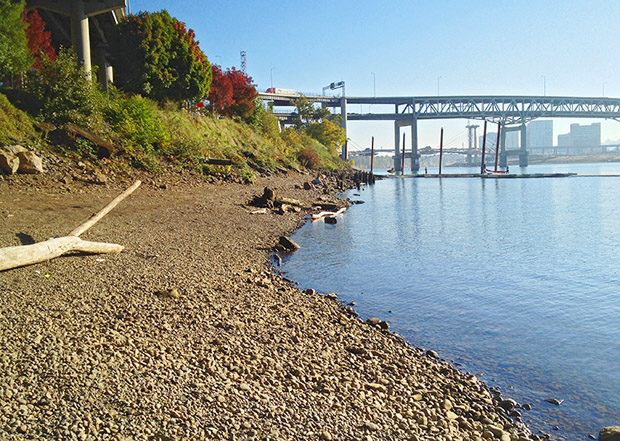
The Audrey McCall Beach is located on the east bank of the Willamette River, where the Human Access Project removed 18 tons of concrete without heavy machinery — thanks to support from the fund.
Grimes’ tours focus on the history of the region — especially the history of the Takelma people who inhabited the Table Rock area before settlers arrived. “Since we aim to tell Oregon’s history from the perspective of the river, it’s important for me to support efforts like these that help preserve our state’s history,” she says.
And due to the statewide reach, the OTPF makes it easy for nimble operations to have a meaningful connection to sustainability programs across the state, with visitors contributing to local projects as well as ones in other parts of the state, like the Human Access Project.
The Human Access Project is one fitting example of the OTPF’s mission to create more sustainable destinations across the state. “Our mission is to transform Portland’s relationship with the Willamette,” says Levenson, explaining that misinformation, not scientific fact, keeps the majority of Portlanders from cherishing the natural resource.
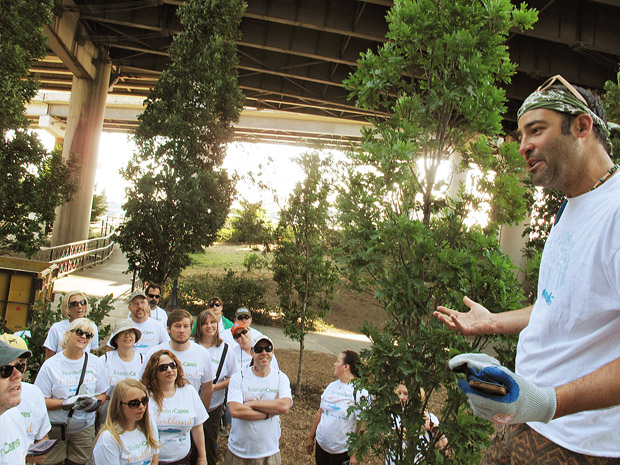
Volunteers for a Tourism Cares event work together to clean the beaches of the Willamette.
The Human Access Project aims to build more access points to Willamette in downtown Portland, and to create opportunities for residents and visitors to recreate in the river and support river-related conservation efforts. While many Oregonians may be familiar with the Big Float — an annual event welcoming hundreds of swimmers to float down the river — the Human Access Project has been using resources from the OTPF to organize volunteer activities and build Audrey McCall Beach, restoring beach access underneath the Hawthorne Bridge.
“I’ve lived in cities that absolutely loved their rivers,” says Levenson, remarking on how unusual it is that so few city residents and visitors enjoy the river during warm summer months. “What will success look like? A city in love with its river,” he says, ruminating on a future where Oregonians and visitors alike recreate in the Willamette.
The potential for tourists to return in several decades and see the tangible impact of their donation excites Dalgaard. “While we’re currently scaling the fund, we’ve already seen positive change,” he says. “I’m really excited about getting visitors to come back and see how their donation has directly affected the destination, so we can together experience a better Oregon.”


